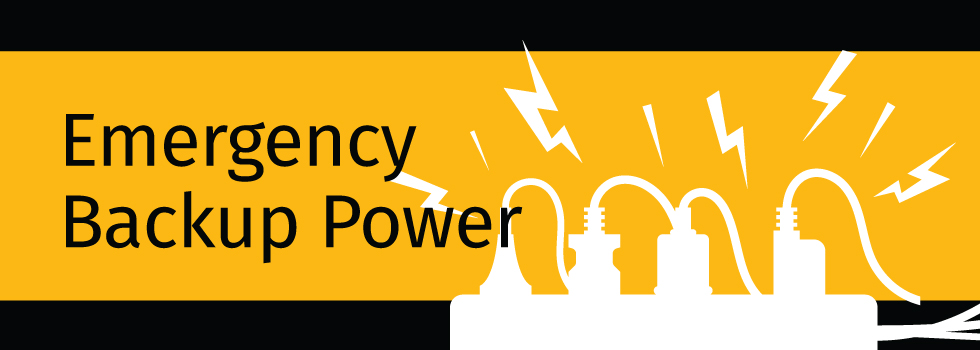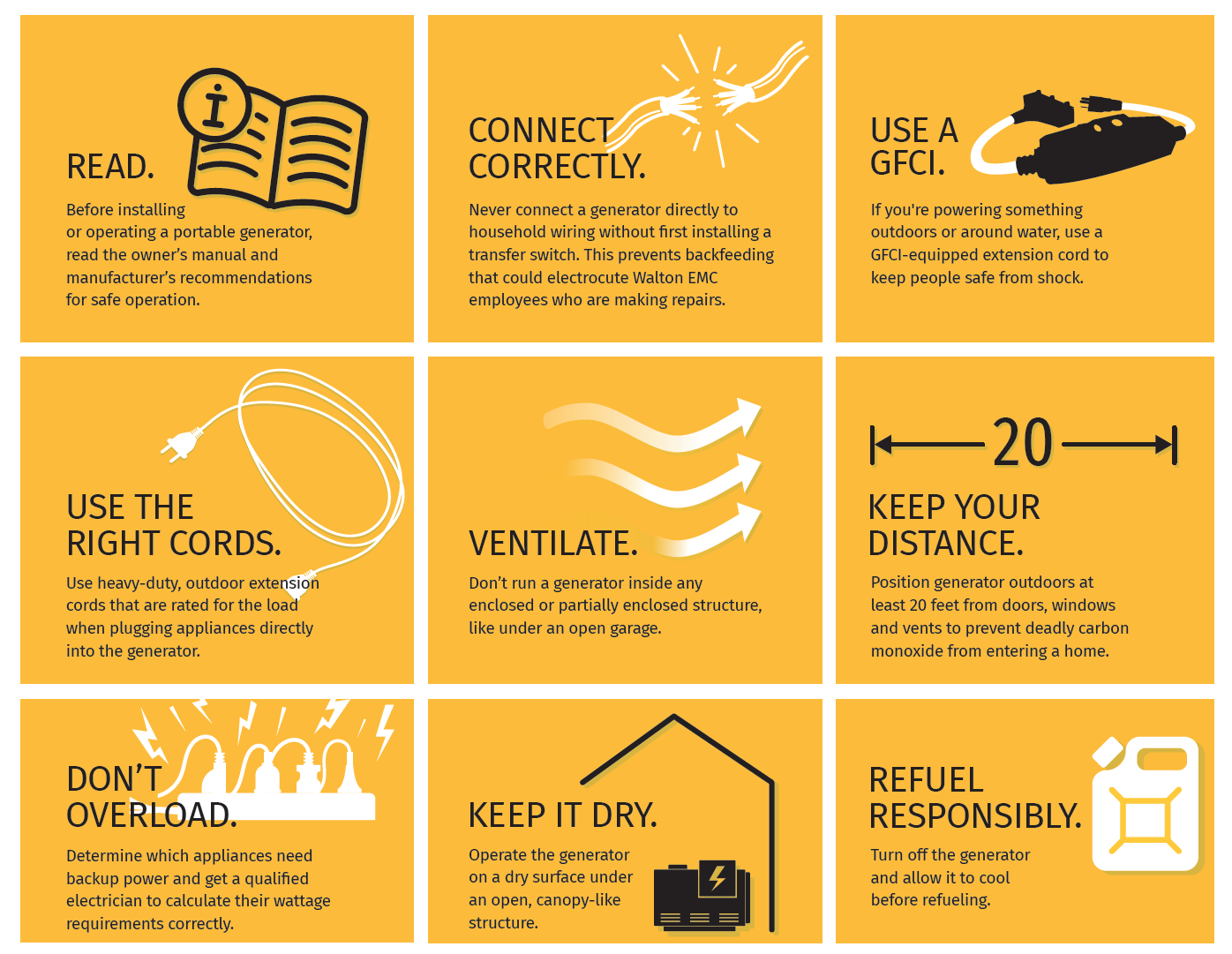Portable generators are convenient, but they can also be dangerous
Often, the most difficult part of Mother Nature’s wrath isn’t the storm itself, but the aftermath. Intense storms can leave damage to the power grid in their wake. Occasionally, that leaves some Walton EMC members in the dark and, in the wintertime, the cold.
Some homeowners use a portable generator to provide backup power as part of their winter emergency preparedness plan. This appliance can temporarily power a few essential appliances or lights to secure you and your home while repairs are made.
A portable generator can provide temporary backup power in an emergency.
Portable generators are a convenience that, when used wisely, provide a safe and comfortable way to wait for electric line repairs. If used improperly, however, they can cause hazardous conditions for the homeowner and for power restoration crews, reminds Brad Adcock, Walton EMC’s director of safety and training.
“A portable generator connected to a home’s wiring or plugged into a regular household outlet can cause backfeeding along power lines,” Adcock said. “This presents an electrocution risk to those working to repair power lines.”
If used improperly, a portable generator can cause hazardous conditions for the homeowner and for power restoration crews.
Walton EMC employees aren’t the only ones in danger when a portable generator is used irresponsibly. Generator owners and their neighbors may be at risk of carbon monoxide (CO) poisoning, fire or electrocution if necessary safety rules aren’t followed.
A portable generator’s engine exhaust can cause carbon monoxide poisoning, which can cause serious illness and even death.
“Even if you can’t smell exhaust fumes, you may still have been exposed to carbon monoxide,” Adcock said. “If you start to feel sick, dizzy or weak while using a generator, get fresh air right away. If you experience serious symptoms, get medical attention immediately.”
To stay comfortable and safe, follow safety guidelines for installing, operating and maintaining your portable generator during an outage. Adcock shares his top tips for Walton EMC customer-owners.
Read the manual.
Don’t skip this essential first step. No matter how much you think you know about portable generators, never attempt to install or operate one without first reading the owner’s manual and manufacturer’s recommendations for safe operation. Never cut corners when it comes to safety.
Don’t skimp.
Buy only generator equipment that is certified by a nationally recognized testing laboratory, such as UL, Intertek or CSA. Quality generators, transfer switches and related accessories designed for connecting a portable system are available from electrical supply or home improvement stores.
Connect correctly.
It’s both illegal and deadly to directly connect a generator to your home’s electrical panel or into a standard household wall outlet. Doing so can cause backfeeding along power lines and electrocute anyone coming in contact with them, including line workers making repairs. At the very least, it can damage expensive appliances.
You have two safe choices for connecting your home appliances to temporary backup power. You can use extension cords to plug a limited number of appliances directly into the portable generator. Or, you can have a qualified, licensed electrician install a manual generator transfer switch that can be triggered to safely move the electrical load from the household power source to the portable generator in an emergency.
The biggest benefit of having a transfer switch in a residential setting is that you gain the ability to power things up via your circuit breaker panel instead of having a tangled web of extension cords scattered throughout your home. This includes hardwired devices, such as your dishwasher, hot water heater and electric heat pump. All you have to do is plug the portable generator into the transfer switch and you’re good to go.
Be cautious around water.
Use an extension cord that includes a ground fault circuit interrupter (GFCI) outlet if you are going to power something outdoors or close to water with the generator. A GFCI helps prevent electric shock, especially in damp conditions, by cutting the power as soon as electricity begins to flow outside its intended path. GFCIs can be integrated into longer extension cords.
Note: A GFCI does not replace grounding a generator. Ensure that the generator is properly grounded according to the manufacturer’s instructions.
Use the right cords.
If you’ll be plugging individual appliances directly into the generator, use heavy-duty, outdoor-rated cords with a wire gauge adequate for the appliance load. Don’t use extension cords with a worn coating, cuts or tears. A worn-out cable can cause fires or equipment damage.
Ventilate.
Don’t run a generator inside any enclosed or partially enclosed structure, such as an open garage. Proper ventilation is essential to avoid exposure to dangerous or even fatal levels of carbon monoxide. The Consumer Product Safety Commission recommends generators be positioned at least 20 feet from doors, windows and vents (yours and your neighbor’s) to prevent deadly CO from entering a home. Install battery-operated CO detectors inside your home as an extra layer of protection from CO poisoning.
Avoid overloading.
A portable generator should only be used when necessary to power essential equipment or appliances. It’s unlikely that your portable generator will be large enough to handle all the lights, appliances, TV, etc. in your home at one time. To prevent dangerous overloading, determine which appliances are essential (and therefore receiving generator power) and get a qualified electrician to calculate their wattage requirements correctly.
Keep it dry.
Operate your generator on a dry surface under an open, canopy-like structure and make sure your hands are dry before touching the generator. Do not use the generator in rainy or wet conditions.
Refuel responsibly.
Never fuel a generator while it is operating. Turn the generator off and let it cool first. Use the type of fuel recommended in the manufacturer’s instructions. Store fuel safely.
Walton EMC encourages you to know and follow the rules for safe operation of a portable generator. You’ll not only be protecting the wellbeing and safety of your family during outages, but also safeguarding those who come to your aid during emergency situations. When we work together for safety, we all benefit.
This information is posted in the interest of the safety of our members and employees. Walton EMC is not responsible for any damage or injury resulting from or omitted from these generator safety tips.
A Better Solution
While portable generators are a convenience, they can cause hazardous conditions if used improperly. Learn more Walton EMC’s whole-house standby generator program that can eliminate these dangers. Investing in a whole-house standby generator can provide comfort, security and convenience in the event of an emergency.
Walton EMC has teamed with its own materials supply cooperative, GRESCO, and another Georgia-based electrical solutions company, Anderson Power Services, to make it easy for co-op customer-owners to purchase and install a quality home standby generator at a competitive price. In addition, the co-op’s HomePlus Loan is available to finance any generator purchase for qualified EMC members.
Walton EMC customer-owners can schedule a free, no-obligation site survey by calling Anderson Power Services at 770-796-0047. A professional from Anderson will survey your home to review your power needs and provide a quote for a generator unit and installation.
READ MORE
Portable Generator Guide
https://www.waltonemc.com/news/storm-center/portable-generator-guide/
No More Downtime
https://www.waltonemc.com/blog/no-more-downtime/
Be Prepared for Stormy Days
https://www.waltonemc.com/blog/be-prepared-for-stormy-days-2/

